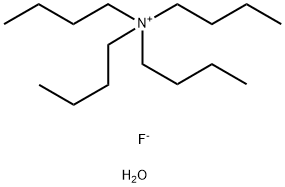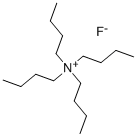Tetrabutylammonium fluoride trihydrate , ≥98.0%(T) , 87749-50-6
Synonym(s):
TBAF;Tetra-n-butylammonium fluoride trihydrate
CAS NO.:87749-50-6
Empirical Formula: C16H38FNO
Molecular Weight: 279.48
MDL number: MFCD00149981
EINECS: 618-063-3
| Pack Size | Price | Stock | Quantity |
| 10G | RMB23.20 | In Stock |
|
| 25g | RMB28.00 | In Stock |
|
| 50G | RMB47.20 | In Stock |
|
| 100g | RMB59.20 | In Stock |
|
| 250G | RMB143.20 | In Stock |
|
| 500g | RMB224.80 | In Stock |
|
| others | Enquire |
PRODUCT Properties
| Melting point: | 62-63 °C(lit.) |
| Flash point: | -17℃ |
| storage temp. | Store below +30°C. |
| form | Crystalline Powder, Crystals and/or Chunks |
| Specific Gravity | 0.887 |
| color | White to slightly yellow |
| PH | pH (50g/l, 25℃) : 5.0~8.0 |
| Water Solubility | SOLUBLE |
| Sensitive | Hygroscopic |
| BRN | 3761900 |
| Exposure limits | ACGIH: TWA 2.5 mg/m3 NIOSH: IDLH 250 mg/m3 |
| InChI | InChI=1S/C16H36N.FH.H2O/c1-5-9-13-17(14-10-6-2,15-11-7-3)16-12-8-4;;/h5-16H2,1-4H3;1H;1H2/q+1;;/p-1 |
| InChIKey | UQCWXKSHRQJGPH-UHFFFAOYSA-M |
| SMILES | [N+](CCCC)(CCCC)(CCCC)CCCC.[F-].O |
| CAS DataBase Reference | 87749-50-6(CAS DataBase Reference) |
Description and Uses
Tetrabutylammonium fluoride trihydrate is a commonly used salt within the realms of organic chemistry and biochemistry. This compound is employed as a potent base, finding extensive use in diverse applications, including organic compound synthesis, buffer preparation, and protein purification. It plays a pivotal role in the synthesis of various organic compounds, such as carboxylic acids, amines, and alcohols. Additionally, this compound facilitates the purification of nucleic acids, including DNA and RNA. Acting as a strong base, tetrabutylammonium fluoride trihydrate possesses the ability to deprotonate a wide range of organic compounds. It is commonly used in applications such as preparation of deprotecting agents, synthesis of lipophilic peprides during DNA transfections, and many more.
Reactant for:
Preparation of deprotecting agents in preparation of cellulose derivatives
Synthesis of lipophilic peptides for DNA transfections in vivo
Dehydrobromination reactions
Safety
| Symbol(GHS) |  GHS07 |
| Signal word | Warning |
| Hazard statements | H302-H315-H319-H412 |
| Precautionary statements | P264-P270-P273-P301+P312-P302+P352-P305+P351+P338 |
| Hazard Codes | C,Xi |
| Risk Statements | 34-36/37/38 |
| Safety Statements | 26-36/37/39-45-26 37/39 |
| RIDADR | UN 1759 8/PG 1 |
| WGK Germany | 3 |
| F | 3-10 |
| Hazard Note | Irritant |
| TSCA | T |
| HazardClass | 6.1 |
| PackingGroup | II |
| HS Code | 38220000 |



